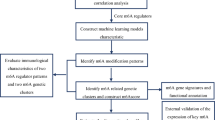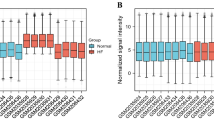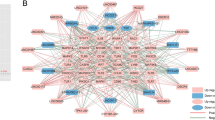Abstract
This study explored the valuable immune gene signature for diagnosis of acute myocardial infarction (AMI). Three training gene expression datasets (GSE48060, GSE34198, and GSE97320) and one validation dataset (GSE109048) were downloaded from GEO database. The differentially infiltrated immune cells were analyzed by CIBERSORT. The immune genes were screened by WGCNA with differential immune cells as phenotype. Differentially expressed genes were analyzed in training datasets, followed by differential immune gene identification. The immune genes with diagnostic value were filtered by univariate regression analysis and LASSO model construction. ROC curve evaluated the diagnostic value of this model. A total of 304 differential immune genes were obtained, which were closely related to immune response-related pathways. An 11-gene signature (ADAMTS1, CNN2, DHRS13, DUSP1, FASLG, GNPTAB, NARF, PHC2, RAB7A, VNN3, and YIPF3) was filtered to be diagnostic biomarker for AMI (AUC = 0.805) and validated in GSE109048 dataset (AUC = 0.608). Based on the diagnostic model, high- and low-risk groups showed ten differential immune cells (such as T cells gamma delta, Macrophages M0, and Neutrophils) and differentially activated immune pathways (such as Antigen_Processing_and_Presentation and Cytokine_Receptors). PHC2 showed the highest positive correlation with Neutrophils and Cytokine_Receptors. The 11-gene signature could be served as a novel biomarker for the presence of AMI.
This is a preview of subscription content, access via your institution
Access options
Subscribe to this journal
Receive 6 digital issues and online access to articles
$119.00 per year
only $19.83 per issue
Buy this article
- Purchase on Springer Link
- Instant access to full article PDF
Prices may be subject to local taxes which are calculated during checkout






Similar content being viewed by others
Data availability
The data that support the findings of this study are available from the corresponding author, upon reasonable request.
References
Reindl M, Reinstadler SJ, Feistritzer H-J, Mayr A, Klug G, Marschang P, et al. Acute myocardial infarction as a manifestation of systemic vasculitis. Wien Klinische Wochenschr. 2016;128:841–3.
Benjamin EJ, Virani SS, Callaway CW, Chamberlain AM, Chang AR, Cheng S, et al. Heart disease and stroke statistics—2018 update: a report from the American Heart Association. Circulation. 2018;137:e67–e492.
Chaulin AM, Duplyakov DV. Biomarkers of acute myocardial infarction: diagnostic and prognostic value. Part 1. J Clin Pract. 2020;11:75–84.
White HD, Chew DP. Acute myocardial infarction. Lancet (Lond, Engl). 2008;372:570–84.
Thygesen K, Alpert JS, White HD. Universal definition of myocardial infarction. Eur Heart J. 2007;28:2525–38.
Jaffe AS, Babuin L, Apple FS. Biomarkers in acute cardiac disease: the present and the future. J Am Coll Cardiol. 2006;48:1–11.
Morrow D, Cannon C, Jesse R, Newby L, Ravkilde J, Storrow A, et al. National Academy of Clinical Biochemistry Laboratory Medicine Practice Guidelines: clinical characteristics and utilization of biochemical markers in acute coronary syndromes. Circulation. 2007;115:e356–75.
Reiter M, Twerenbold R, Reichlin T, Haaf P, Peter F, Meissner J, et al. Early diagnosis of acute myocardial infarction in the elderly using more sensitive cardiac troponin assays. Eur Heart J. 2011;32:1379–89.
Wang C, Jing Q. Non-coding RNAs as biomarkers for acute myocardial infarction. Acta Pharmacologica Sin. 2018;39:1110–9.
Fernández-Ruiz I. Immune system and cardiovascular disease. Nat Rev Cardiol. 2016;13:503–503.
Caligiuri G, Nicoletti A. Lymphocyte responses in acute coronary syndromes: lack of regulation spawns deviant behaviour. Eur Heart J. 2006;27:2485–6.
Weil BR, Neelamegham S. Selectins and immune cells in acute myocardial infarction and post-infarction ventricular remodeling: pathophysiology and novel treatments. Front Immunol. 2019;10:300.
Prabhu SD, Frangogiannis NG. The biological basis for cardiac repair after myocardial infarction: from inflammation to fibrosis. Circulation Res. 2016;119:91–112.
Nahrendorf M, Swirski FK. Innate immune cells in ischaemic heart disease: does myocardial infarction beget myocardial infarction? Eur Heart J. 2016;37:868–72.
Chen B, Khodadoust MS, Liu CL, Newman AM, Alizadeh AA. Profiling tumor infiltrating immune cells with CIBERSORT. Methods Mol Biol (Clifton, NJ). 2018;1711:243–59.
Langfelder P, Horvath S. WGCNA: an R package for weighted correlation network analysis. BMC Bioinforma. 2008;9:559.
Dennis G Jr., Sherman BT, Hosack DA, Yang J, Gao W, Lane HC, et al. DAVID: Database for Annotation, Visualization, and Integrated Discovery. Genome Biol. 2003;4:P3.
Szklarczyk D, Franceschini A, Kuhn M, Simonovic M, Roth A, Minguez P, et al. The STRING database in 2011: functional interaction networks of proteins, globally integrated and scored. Nucleic acids Res. 2011;39:D561–8. Database issue.
Shannon P, Markiel A, Ozier O, Baliga NS, Wang JT, Ramage D, et al. Cytoscape: a software environment for integrated models of biomolecular interaction networks. Genome Res. 2003;13:2498–504.
Gómez-Rubio V. ggplot2—elegant graphics for data analysis (2nd ed) J. Stat. Softw., Book Rev. 2017;77:1–3.
Bhattacharya S, Andorf S, Gomes L, Dunn P, Schaefer H, Pontius J, et al. ImmPort: disseminating data to the public for the future of immunology. Immunologic Res. 2014;58:234–9.
Suárez-Fariñas M, Lowes MA, Zaba LC, Krueger JG. Evaluation of the psoriasis transcriptome across different studies by gene set enrichment analysis (GSEA). PLoS One. 2010;5:e10247.
Yan X, Anzai A, Katsumata Y, Matsuhashi T, Ito K, Endo J, et al. Temporal dynamics of cardiac immune cell accumulation following acute myocardial infarction. J Mol Cell Cardiol. 2013;62:24–35.
Saleh M, Ambrose J. Understanding myocardial infarction. F1000Research 2018;7:F1000.
Zang QS, Sadek H, Maass DL, Martinez B, Ma L, Kilgore JA, et al. Specific inhibition of mitochondrial oxidative stress suppresses inflammation and improves cardiac function in a rat pneumonia-related sepsis model. Am J Physiol Heart Circulatory Physiol. 2012;302:H1847.
Xu JY, Xiong YY, Lu XT, Yang YJ. Regulation of type 2 immunity in myocardial infarction. Front Immunol. 2019;10:62.
Frangogiannis NG. Regulation of the inflammatory response in cardiac repair. Circulation Res. 2012;110:159–73.
Marchant DJ, Boyd JH, Lin DC, Granville DJ, Garmaroudi FS, McManus BM. Inflammation in myocardial diseases. Circulation Res. 2012;110:126–44.
Shao G. Integrated RNA gene expression analysis identified potential immune-related biomarkers and RNA regulatory pathways of acute myocardial infarction. PLoS One. 2022;17:e0264362.
Zhang L, Wang Q, Xie X. Identification of biomarkers related to immune cell infiltration with gene coexpression network in myocardial infarction. Dis Markers. 2021;2021:2227067.
Sheu J-J, Sung P-H, Leu S, Chai H-T, Zhen Y-Y, Chen Y-C, et al. Innate immune response after acute myocardial infarction and pharmacomodulatory action of tacrolimus in reducing infarct size and preserving myocardial integrity. J Biomed Sci. 2013;20:82.
Saparov A, Ogay V, Nurgozhin T, Chen WCW, Mansurov N, Issabekova A, et al. Role of the immune system in cardiac tissue damage and repair following myocardial infarction. Inflamm Res. 2017;66:739–51.
Aydin S, Ugur K, Sahin İ, Yardim M. Biomarkers in acute myocardial infarction: current perspectives. Vasc Health Risk Manag. 2019;15:1–10.
Duque-Ossa L, García-Ferrera B, Reyes-Retana J. Troponin I as a biomarker for early detection of acute myocardial infarction. Curr Probl Cardiol. 2021:101067.
Ma Y, Yabluchanskiy A, Lindsey ML. Neutrophil roles in left ventricular remodeling following myocardial infarction. Fibrogenes Tissue Repair. 2013;6:11.
Timmers L, Pasterkamp G, de Hoog VC, Arslan F, Appelman Y, de Kleijn DP. The innate immune response in reperfused myocardium. Cardiovascular Res. 2012;94:276–83.
Yu C, Zhou W. Peripheral neutrophils and naive CD4 T cells predict the development of heart failure following acute myocardial infarction: a bioinformatic study. Rev Port Cardiol (Engl Ed). 2021;40:839–47.
Fleming ND. Molecular regulation of cardiovascular development and disease. Chapel Hill: The University of North Carolina; 2019.
Ueda K, Takahashi M, Ozawa K, Kinoshita M. Decreased soluble interleukin-6 receptor in patients with acute myocardial infarction. Am Heart J. 1999;138:908–15.
Acknowledgements
This study was funded by General fund of Wuxi Health Commission (MS201806).
Author information
Authors and Affiliations
Contributions
NZ designed the study and analyzed the data. BZ carried out the experiment. ST wrote the manuscript. All authors have read the manuscript and approved its publication.
Corresponding author
Ethics declarations
Competing interests
The authors declare no competing interests.
Additional information
Publisher’s note Springer Nature remains neutral with regard to jurisdictional claims in published maps and institutional affiliations.
Supplementary information
Rights and permissions
Springer Nature or its licensor holds exclusive rights to this article under a publishing agreement with the author(s) or other rightsholder(s); author self-archiving of the accepted manuscript version of this article is solely governed by the terms of such publishing agreement and applicable law.
About this article
Cite this article
Zhang, N., Zhou, B. & Tu, S. Identification of an 11 immune-related gene signature as the novel biomarker for acute myocardial infarction diagnosis. Genes Immun 23, 209–217 (2022). https://doi.org/10.1038/s41435-022-00183-7
Received:
Revised:
Accepted:
Published:
Issue Date:
DOI: https://doi.org/10.1038/s41435-022-00183-7
This article is cited by
-
Immune response stability to the SARS-CoV-2 mRNA vaccine booster is influenced by differential splicing of HLA genes
Scientific Reports (2024)
-
Potential diagnostic biomarkers: 6 cuproptosis- and ferroptosis-related genes linking immune infiltration in acute myocardial infarction
Genes & Immunity (2023)



